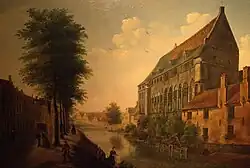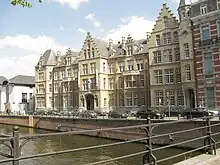Major Seminary, Ghent
The Major Seminary in Ghent was an institution for the training of Catholic clergy for the diocese of Ghent, first founded in 1569. It has been established at three different locations in the city. Since 2006 diocesan clergy from Ghent have been trained in Leuven.
1569–1623

The seminary was founded in the Geeraard de Duivelsteen by Cornelius Jansen, the first bishop of Ghent, in accordance with the decrees of the Council of Trent.
1623–1925
.jpg.webp)
In 1623 Bishop Anthonius Triest acquired a new property on Biezekapelstraat, next to Ghent Cathedral, to house the seminary. This building was heavily renovated and extended in the 18th century, with much of the work commissioned from the architect-contractor David 't Kindt (1699-1770) by Bishop Maximiliaan Van der Noot.[1] With a hiatus between 1797 and 1830, it was in use until 1925.[2] During the French occupation it was in use as a barracks. It has been recognised as built heritage since 2009 and a protected monument since 2013.[2] For much of the 20th century the buildings housed a school.[2] They are now a diocesan activity centre,[3] housing libraries and archives.[4]
1925–2002

In 1925 the seminary was relocated to a purpose-built neo-traditionalist complex on the Reep. This complex was recognised as built heritage in 2009.[5] Vlerick Business School acquired the use of the buildings in 2002.
Notable alumni and staff
References
- "Bisschoppelijk Seminarie". Shoppen en toerisme in Gent (in Dutch). City of Ghent.
- "Bisschoppelijk Seminarie ID: 24488". Inventaris onroerend erfgoed (in Dutch). Flemish organization for Immovable Heritage. 2019.
- Karel Van Keymeulen (17 September 2015). "Sint-Baafshuis naast kathedraal krijgt nieuw leven". De Standaard (in Dutch).
- "Twee bibliotheken onder één dak". Kerknet (in Dutch). 26 June 2018.
- "Bisschoppelijk Seminarie ID:19631". Inventaris onroerend erfgoed (in Dutch). Flemish organization for Immovable Heritage. 2019.